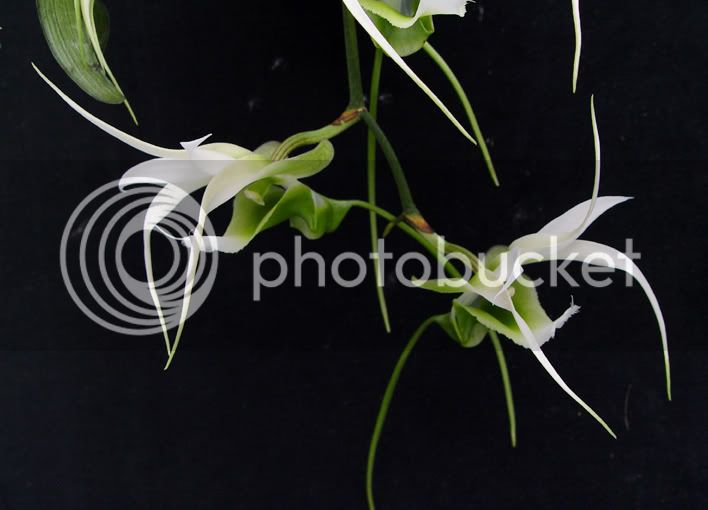Ok, be patient with me. I am learning and will probably end up embarassing myself by posting this, but here it goes...
I understand that it is probably the scent of the nectary that attracts the moth to the orchid. But now we know that there are moths in the family that pollenate these orchids that do land on the orchid to feed. The moth that pollenates the Angraecum sesquipedale hovers, because it has a super long nectary to navigate with its super long probiscus. If you look at the photo above of this moth feeding, you will notice that the nectary of sesquipedale appears to be a straight tube. The nectary of the Aeranthes we are discussing does not. Look at this photo...
You will notice that there are two "pouches" on the nectary of the Aeranthes. I want to assert that the moth that pollenates this flower lands to feed, and these pouches have evolved to allow the moth to unfurl it's probiscus after landing. The nectary on the Aeranthes appears to be not nearly as long as the nectary on Ang. sesquipedale, so the moth probably has a much shorter probiscus.
Now, if this is true, and the moth does land to feed, and the pouches do allow the moth room to navigate a medium to small probiscus, then I have the following question to answer. Why is the lip shaped like a moth? I just did an image search on google for the Noctuidae moth, and found photos and drawings of these moths. The one thing I noticed is that the shape of the wing of most of these moths is almost exactly the same shape as the edge of the lip on this orchid. I can mock up a photoshop image that shows this if you want, but I don't think it's necessary. It is very obvious to me that the lip is shaped just like a moth. It even has "fringe" on the edge of the lip, just like most moths have fringe on the edge of their wing.
So why is the lip shaped like a moth? Evolution shows us that plants have "changed" color to match their environment after plants that stood out were eaten by foraging animals. Lithops taught me that. The plants that were the wrong color were eaten, therefore the plants that were well hidden passed along their color to the next generation.
Is it so unbelievable to think that this orchid might have a lip shaped like a moth, because over time the plants that had a lip shaped more like a moth were pollenated, and the plants with a lip not shaped like a moth were not pollenated? Why would a moth be more likely to pollenate a plant that had a lip shaped like a moth? The only theory I can come up with is that there must be a predator that is less likely to find a moth when it is settled on a plant that mimics it's shape.
I may be way off base here, overthinking the process of evolution. But every bit of information I find out about moths, Aeranthes, Madagascar and evolution brings up more questions. Now I really want one of these plants. : )





